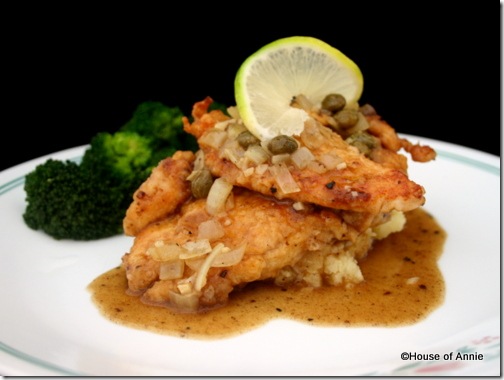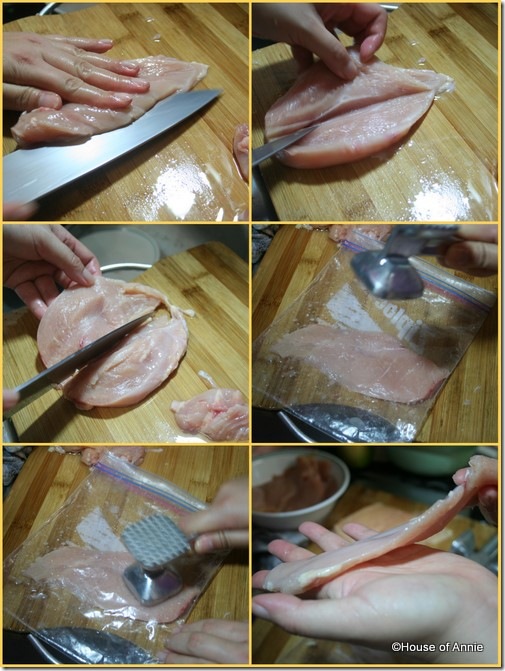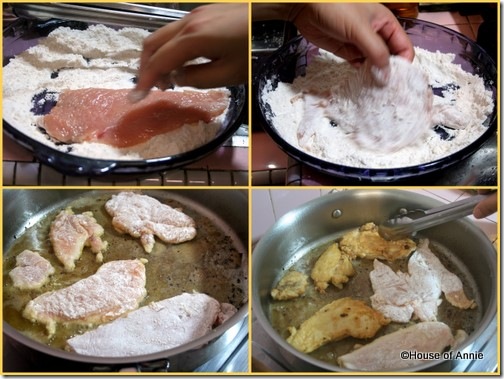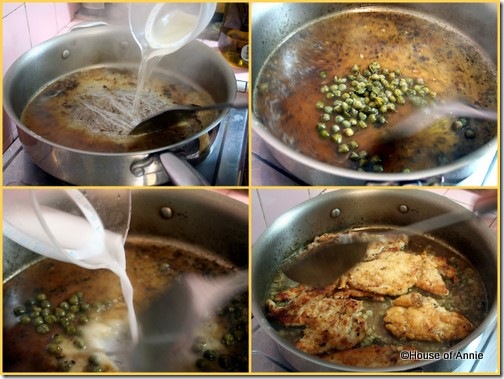Chicken breasts, pan-fried in butter and olive oil, and doused in an addictive, savory, tangy sauce.
I’ve so broken my New Year’s Resolution already. “Two posts a week,” I said. Hah! I haven’t written a post in forever. I won’t mention how long. Poor Nate has had to fill in for my lack by writing all about our trip to Hawaii. In the meantime, he has been discreetly trying to prod me to write some recipes (ie. not nag me to write as I get perverse and even more won’t do it).
It’s not like I haven’t cooked anything new. I’ve just been so busy with work since getting back from our vacation that I have not had time to blog. Well, that’s not entirely true…when I am free, all I want to do is sit in front of the computer and play Zuma Blitz (it’s totally mind-numbing and addictive!).
But today, I decided I had to get going again before I lost all my writing chops. So here I am writing about a dinner I made a while ago and one I have made many times—Chicken Piccata.
Favorite Dish
The first time I had Chicken Piccata was when Nate and I were at California Pizza Kitchen with another couple and the husband ordered Chicken Piccata. He told us it was his favorite thing to have there. When it arrived, I asked if I could have a taste and it was fabulous! The sauce with the lemons and capers were tangy and savory—very addictive. It made you want to keep on eating. I reluctantly returned his dish and wished that I had ordered the same thing (don’t you hate when someone else’s dish is so much better than what you ordered?).
So with that flavor imprinted in my head, I decided that I had to learn how to make this dish. I looked up recipe after recipe online and after checking a bunch, I decided to just wing it on my own using my understanding from making another chicken dish (Chicken Marsala—another one I have not posted!). And it was very good. I even invited my friends over for dinner and the husband pronounced my Chicken Piccata delicious!
Lessons Learned
It must have been beginner’s luck, because the next time I tried it, it was horrible. Serves me right for not writing my recipe down and thinking I’d know what to do the next time around. So I got back online and researched all the recipes again and tried them out again. Here’s what I’ve learned from making Chicken Piccata several times now:
1. The sauce is key. It is a matter of getting the right balance of tart from the lemon and smoothly savory rich from the butter and chicken stock (a little wine doesn’t hurt either). Because everyone’s lemon is going to have a different level of tartness, to get this sauce right, it is important to taste, taste and taste again. It’s also important to not forget that the capers you add at the end also add more salty-sour flavors.
2. Besides the butter, adding a little cornstarch slurry to the sauce helps to thicken it. Some people like to add flour in the beginning to make a roux and that’s fine too but I don’t like stirring flour and getting all the clumps out so I find that just making a cornstarch slurry to thicken it works just as well.
3. Don’t add sugar if you find the sauce is too tart (don’t ask me how I know). This is not sweet sour sauce. If you have added too much lemon juice and you find your sauce is too tart, just add more chicken stock and butter to enrich the sauce. Have I stressed the importance of tasting? And too much sauce is never a bad thing, as a matter of fact, I always wish I had made more when I’m making this dish (it doesn’t matter the carb vehicle you use to eat this with (potatoes or pasta), all of it will beg for more sauce.
4. It’s fine to add some aromatics to the sauce though it’s not needed. I’ve been known to sauté a little garlic and shallots after browning the chicken pieces. It’s also nice to add some chopped parsley at the end for a little green “herb” contrast to all the rich flavors. And I’ve also been known to add some sliced mushrooms to my Chicken Piccata sauce. I know, it’s not usual, but I like it and it works. Never wrong to play with your food.
5. It’s good to pound your chicken flat so that it cooks faster and doesn’t get dried out. This is chicken breast after all, and you want the chicken to be cooked through but not dried out. Flattening the chicken helps, I normally cut the chicken breast into two pieces length-wise and then flatten them. Coating it with some flour before pan frying also helps. I normally get a pie plate and put my flour in with some salt and pepper. Then all I have to do is dredge the flattened chicken and shake off the excess before browning it in my large sauté pan.
Butterflying and Flattening Chicken Breasts
6. Sauté the chicken in olive oil AND butter. The butter helps to give the chicken a lovely golden brown color and also add flavor of course! Don’t crowd the pieces in the pan, give each piece enough time to develop color and then flip and brown the other side (remembering that the other side will take less time than the first). Do add more oil if you find you are running out. Set the browned chicken aside while you finish the rest.
Right, so on with the recipe and remember, measurements for the sauce are approximations and you will need to taste to find the right balance for yourself.
Chicken Piccata Recipe
Prep time: 30 min, Total time: 60 min
Yield: 4 servings
Ingredients
4 chicken breasts, cut in half length-wise and then flattened
1 cup all-purpose flour
2 tsp kosher salt
1 tsp ground black pepper
2 Tbsp olive oil
1 Tbsp butter
3-4 cloves garlic, minced*
1 small onion, finely diced*
1 cup sliced white/brown mushrooms*
1/2 cup dry vermouth / white wine
1 cup + 1/4 cup low-sodium chicken broth
1 Tbsp cornstarch
1/4 cup lemon juice
1/4 cup capers, drained
2 Tbsp butter
salt and pepper to taste
chopped parsley to garnish
Method
- Mix AP flour with 2 tsp salt and 1 tsp black pepper in a pie plate.
- Heat up olive oil and butter in a large sauté pan over medium heat. Dredge flattened chicken in flour mixture and shake to get rid of excess flour. Brown on one side for about 3-4 mins until golden brown then flip and brown the other side, another 2-3 mins. Do not crowd the chicken pieces. Remove from pan and cover with foil to keep warm.
- If adding garlic and onions, add a little bit more oil if the pan is dry and sauté till wilted.
- Pour in vermouth, 1 cup chicken broth, and lemon juice and scrape the pan to loosen all the yummy brown bits. Bring to a boil. If adding mushrooms, add now and cook for about 4 minutes, bringing heat down to medium.
- Add the slurry and stir to thicken. Once the sauce has thickened, turn the heat down to low and add the capers and butter. Taste the sauce and season with salt and pepper. Adjust seasonings with more lemon juice or chicken stock as needed. The flavors should be sour but not puckerishly sour. There should be a nice balance of sour with savory and salty.
- Return chicken to pan to coat with sauce. Garnish with chopped parsley.
Serve Chicken Piccata over mashed potatoes or pasta (we like using angel hair with this).
Enjoy!
Cheers, Annie
For its use of capers, I am entering this post in the Weekend Herb Blogging roundup #277, organized by Haalo and hosted this week by Susan of The Well-Seasoned Cook.




Capers certainly are addictive, but impossible to describe. A very snazzy sauce.
And a very fine tutorial, too; a great help to see everything so meticulously stepped out in photos.
Thanks for your great WHB recipe!
Haha, good for Nate to prod you in a gentle way. I am loving this recipe, and I found your advice NOT to put sugar helpful as I usually do that!! So butter or stock is the solution…ah…when is butter ever NOT the solution? 😉
An oldie, but goodie. Chicken piccata is always a pleasure to eat, what with that crispy coating and that tangy-salty bright sauce. It’s like you said — it seems like a simple dish, but you have to be so exacting then, because there are no frills to hide behind.
Stock is the key…. Thanks for the tip!
I adore chicken piccata. But the last time I had it was at an Italian restaurant outside of Chicago ten+ years ago so your post has inspired me. Like you, I prefer a cornstarch slurry and will use a wheat free flour, (perhaps rice) instead of AP flour.